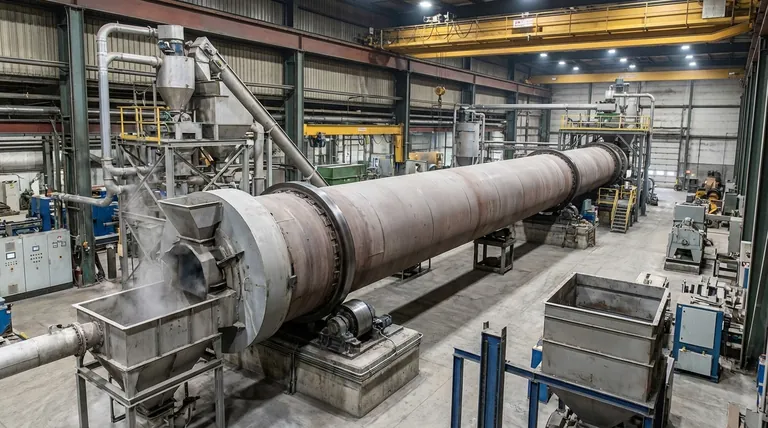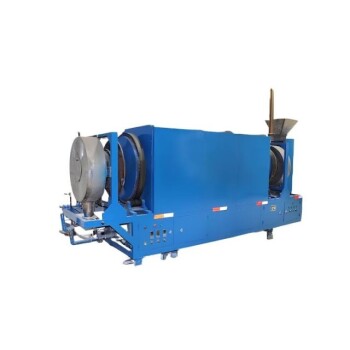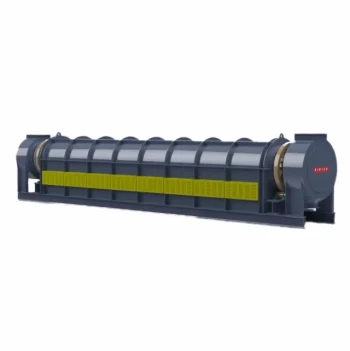At its core, a rotary kiln is a highly efficient industrial furnace that uses a simple combination of gravity and rotation to continuously process materials. It consists of a long, rotating cylindrical tube inclined at a slight angle. Raw material is fed into the higher end, and as the kiln slowly turns, the material tumbles and gradually moves down to the lower end, ensuring it is mixed and heated uniformly along its journey.
The essential principle of a rotary kiln is not just the application of heat, but the precise control over how a material experiences that heat over time. Its design ingeniously uses inclination and rotation to manage material flow, mixing, and heat exposure in a continuous, scalable process.

The Core Operating Principles
To understand how a rotary kiln achieves its goal, you must look at the interplay of three key factors: the physical movement of the material, the method of heat transfer, and the controlled environment.
The Role of Inclination and Gravity
The entire kiln body is positioned at a slight downward angle, typically just a few degrees from horizontal. This incline is the primary force that encourages material to move from the feed end to the discharge end. Gravity ensures a constant, predictable direction of flow.
The Function of Slow Rotation
The kiln rotates slowly on its longitudinal axis, usually at just a few revolutions per minute. This rotation serves two critical functions.
First, it creates a tumbling or cascading motion inside the kiln. This constant mixing is vital for ensuring every particle is uniformly exposed to the heat source, preventing hot spots and guaranteeing a consistent final product.
Second, the rotation works with the incline to "walk" the material down the length of the cylinder. The speed of rotation is a primary control lever; increasing the speed generally reduces the retention time (the duration the material spends inside the kiln).
The Critical Path of Material Flow
The process is continuous. Material is introduced at a controlled rate at the upper end, often by a screw feeder. It then travels through distinct heating zones as it moves down the kiln, undergoing the required physical changes or chemical reactions before exiting at the lower discharge end.
Understanding Heat Transfer Methods
The "how" of a rotary kiln is incomplete without understanding how heat is actually applied. The choice between direct and indirect heating is fundamental and defines the kiln's capabilities.
Direct-Fired Kilns
In a direct-fired system, a burner shoots a flame or hot gases directly into the kiln's interior. This is the most common method for large-scale industrial processes like cement manufacturing.
Often, the gas flow is counter-current, meaning the hot gas is introduced at the discharge end and flows up toward the feed end, opposite to the material's path. This is highly efficient, as the hottest gases meet the most-processed material, and the cooler gases preheat the incoming raw material.
Indirect-Fired Kilns
In an indirect-fired system, the kiln's cylindrical shell is heated from the outside. This can be done using electrical heating elements or an external furnace or "firebox" that envelops the rotating tube.
The material inside never comes into contact with combustion byproducts. This method allows for precise temperature control and is essential when processing materials that are sensitive to contamination or require a specific controlled atmosphere.
Understanding the Trade-offs
No single design is perfect for every application. The choice between direct and indirect heating involves significant trade-offs in efficiency, purity, and scale.
Direct Heating: Efficiency vs. Contamination
Direct-fired kilns are exceptionally thermally efficient due to the direct contact between the heat source and the material. However, this direct contact means the product can be contaminated by fuel ash or combustion gases, making it unsuitable for high-purity applications.
Indirect Heating: Purity vs. Scale
Indirect-fired kilns offer superior product purity and precise atmospheric control. The trade-off is often lower thermal efficiency and limitations on physical size; it is mechanically complex and expensive to heat a very large-diameter rotating tube from the outside.
Mechanical Complexity and Maintenance
All rotary kilns are heavy, dynamic machines. They require massive support structures, powerful motors, and robust seals at both ends to control the internal atmosphere and prevent heat loss. This inherent mechanical complexity makes them a significant capital investment with ongoing maintenance requirements.
Matching the Kiln to the Process
The right kiln configuration depends entirely on the specific thermal processing goal for your material.
- If your primary focus is bulk processing and high throughput (e.g., cement, lime, ore reduction): A direct-fired, counter-current kiln is the industry standard due to its unmatched thermal efficiency.
- If your primary focus is product purity or sensitive reactions (e.g., specialty chemicals, soil remediation): An indirect-fired kiln is necessary to maintain precise temperature control and prevent contamination.
- If your primary focus is controlling retention time and mixing uniformity: Adjusting the kiln's rotation speed and inclination angle are your key operational levers, regardless of the heating method.
By mastering these fundamental principles, you can effectively leverage the rotary kiln as a powerful and adaptable tool for continuous material transformation.
Summary Table:
| Feature | Direct-Fired Kiln | Indirect-Fired Kiln |
|---|---|---|
| Heating Method | Flame/gas inside kiln | External heating of shell |
| Best For | High throughput (cement, lime) | High purity, sensitive materials |
| Efficiency | High thermal efficiency | Lower thermal efficiency |
| Product Purity | Risk of contamination | Excellent purity control |
| Scale | Ideal for large-scale operations | Limited by mechanical complexity |
Need a high-temperature furnace solution tailored to your unique process?
At KINTEK, we leverage our exceptional R&D and in-house manufacturing to provide advanced thermal processing solutions. Whether your project requires the continuous processing capabilities of a rotary kiln or the precision of our Muffle, Tube, Vacuum, or CVD/PECVD Systems, our deep customization capabilities ensure your specific experimental and production requirements are met precisely.
Contact our experts today to discuss how we can optimize your material transformation process.
Visual Guide

Related Products
- Electric Rotary Kiln Continuous Working Small Rotary Furnace Kiln for Pyrolysis Plant Heating
- Electric Rotary Kiln Small Rotary Furnace Biomass Pyrolysis Plant Rotating Furnace
- Vacuum Sealed Continuous Working Rotary Tube Furnace Rotating Tube Furnace
- Split Multi Heating Zone Rotary Tube Furnace Rotating Tube Furnace
- Electric Rotary Kiln Pyrolysis Furnace Plant Machine Small Rotary Kiln Calciner
People Also Ask
- How is bed depth controlled in a rotary kiln and why is it important? Optimize Heat Transfer and Efficiency
- How does a rotary kiln function mechanically? Master Material Processing with Precision Engineering
- What are some drying applications of electromagnetic rotary kilns? Discover Efficient, Precise Drying Solutions
- What is the retention time of a rotary kiln? Optimize Your Process Efficiency
- What is the basic working principle of a rotary kiln? Master Industrial Thermal Processing Efficiency



















